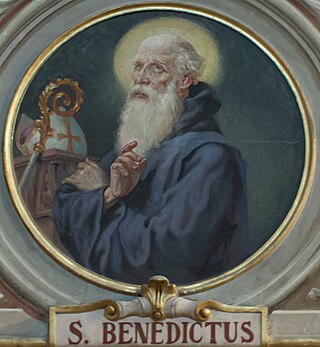Sources
- Filippo Ermini (1930). "BENEDETTO canonico di San Pietro". Enciclopedia Italiana (in Italian).
- Mario da Bergamo (1966). "BENEDETTO". Dizionario Biografico degli Italiani (in Italian).
Benedictus Canonicus Sancti Petri ("Benedict, canon of St. Peter's") was a religious and liturgical writer from Rome [1] active in the first half of the 12th century. [2] Benedict was one of the four canons of the old Basilica of St. Peter, who celebrated mass in the church; almost nothing is known about his life. [2] He is author of the Liber polypticus (or Liber Politicus), [2] in which, among others, is contained the Ordo Romanus ; this book was written between 1140 and 1143, when he was already advanced in years. [1] [2] His work is important because of the contained information about institutions and religious celebrations and feasts of 12th century Rome. [1] [2]

Benedict of Nursia, often known as Saint Benedict, was an Italian Christian monk, writer, and theologian. He is venerated in the Catholic Church, the Eastern Orthodox Church, the Oriental Orthodox Churches, the Anglican Communion, and Old Catholic Churches. In 1964 Pope Paul VI declared Benedict a patron saint of Europe.
Pope Benedict III was the bishop of Rome and ruler of the Papal States from 29 September 855 to his death.
Pope Benedict IX, born Theophylactus of Tusculum in Rome, was the bishop of Rome and ruler of the Papal States for three periods between October 1032 and July 1048. Aged about 20 when first elected, he is the youngest pope in history. He is the only person to have been Pope more than once and the only person ever accused of selling the papacy.

Pope Benedict XIII, born Pietro Francesco Orsini and later called Vincenzo Maria Orsini, was head of the Catholic Church and ruler of the Papal States from 29 May 1724 to his death in February 1730.

Pope Benedict XIV, born Prospero Lorenzo Lambertini, was head of the Catholic Church and ruler of the Papal States from 17 August 1740 to his death in May 1758.
Pope Benedict IV was the bishop of Rome and ruler of the Papal States from 1 February 900 to his death. The tenth-century historian Flodoard, who nicknamed him "the Great", commended his noble birth and public generosity.

The Basilica of Saint Mary Major, or church of Santa Maria Maggiore, is a Major papal basilica as well as one of the Seven Pilgrim Churches of Rome and the largest Catholic Marian church in Rome, Italy.
Canons regular are priests who live in community under a rule and are generally organised into religious orders, differing from both secular canons and other forms of religious life, such as clerics regular, designated by a partly similar terminology.

Ciro Ferri was an Italian Baroque sculptor and painter, the chief pupil and successor of Pietro da Cortona.

The Basilica of the Holy Cross in Jerusalem or Basilica di Santa Croce in Gerusalemme is a Catholic Minor basilica and titular church in rione Esquilino, Rome, Italy. It is one of the Seven Pilgrim Churches of Rome.

The basilica diSan Pietro is a Catholic basilica and abbey in the Italian city of Perugia. Its bell tower, standing at 70 meters tall, is the tallest structure in Perugia and is one of the city's most significant symbols. It is an Italian national monument

The Basilica of Sant'Ambrogio is an ancient Romanesque-style, Roman Catholic church in the center of Milan, region of Lombardy, Italy.

The Diocese of Bergamo is a Latin diocese of the Catholic Church in Italy, and is a suffragan of the Archdiocese of Milan. Geographically, Bergamo stood between the mainland interests of the Republic of Venice, and the territory of the Duchy of Milan. The duchy was regularly contested by the French and the Holy Roman Empire, which brought about repeated military operations. Internally, from the 12th to the 15th century, there was the usual party strife between the Guelphs, who generally supported the political and religious policies of the Papacy; and the Ghibellines, who generally supported the Emperors. As Kings of Italy, the emperors were feudal overlords of Lombardy.
Pier Paolo Vergerio was an Italian humanist, statesman, pedagogist and canon lawyer.

Bergamo Cathedral is a Roman Catholic cathedral in Bergamo, Italy, dedicated to Saint Alexander of Bergamo, patron saint of the city. It is the seat of the Bishop of Bergamo.

Benedict was Archbishop of Milan from c. 685–732. He is honoured as a saint in the Catholic and Eastern Orthodox Churches.

Venturino of Bergamo was an Italian Dominican preacher.

San Macuto is a Catholic church located on Piazza di San Macuto in the Colonna rione of Rome, Italy. Located next to the Jesuit Collegio di San Roberto Bellarmino in the Palazzo Gabrielli-Borromeo, it is the only church in Italy dedicated to the 7th century Breton saint Malo.
The Catholic Church utilizes the oldest continuously functioning legal system in the West, much later than Roman law but predating the evolution of modern European civil law traditions. The history of Latin canon law can be divided into four periods: the jus antiquum, the jus novum, the jus novissimum and the Code of Canon Law. In relation to the Code, history can be divided into the jus vetus and the jus novum. Eastern canon law developed separately.

Benedict of Bari, Italian Benedetto da Bari, Latin Benedictus Barensis, was a Benedictine monk of Santissima Trinità della Cava dei Tirreni who wrote the Christian theological treatise De septem sigillis. This is the only major work of theology written at La Cava.